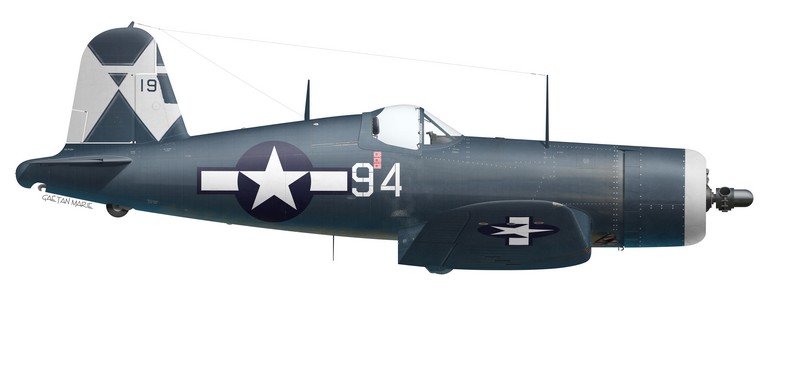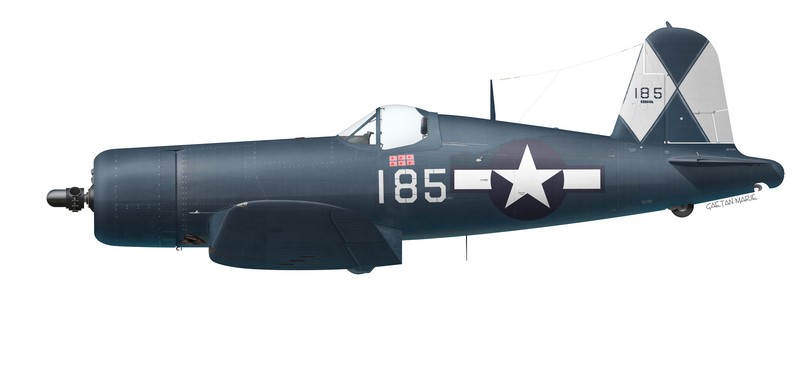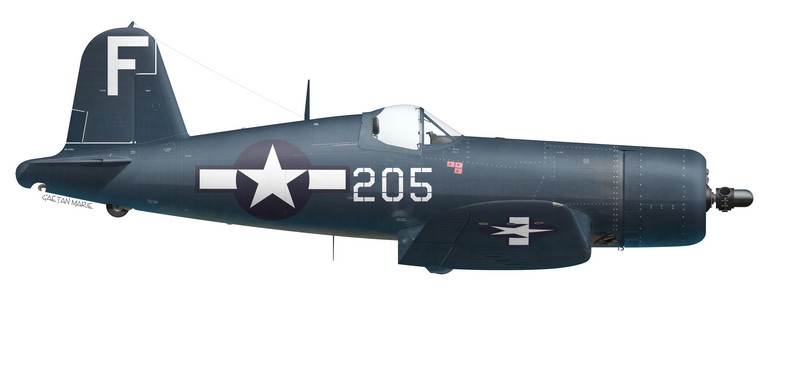Carrier Air Group 83 (CVG-83) was assigned to the USS Essex in early 1945 and was composed of several squadrons: VF-83 (F6F-5, F6F-5N, F6F-5P), VBF-83 (F4U-1D, FG-1D), VB-83 (SB2C-4E) and VT-83 (TBM-3E).
The Air Group saw action in the Pacific theatre from 10 March to 15 September 1945, participating in raids on Kyushu, supporting the invasion of Okinawa, hunting down the Japanese battleship Yamato and conducting air strikes against the Japanese home islands. Its Corsairs achieved some success against Japanese aircraft, most notably on 18 March 1945 when VBF-83 claimed 18 aerial victories for no loss of their own.
VBF-83 flew the F4U-1D Corsair or its equivalent the Goodyear FG-1D. The markings of the Corsairs varied quite a bit between March and September, as shown by these profiles.

This F4U-1D (or perhaps FG-1D) Corsair carried typical markings of the beginning of the Essex’s 1945 cruise. The aircraft sports two white rhombuses, the geometric markings identifying aircraft belonging to CVG-83. These were generally known as “G symbols”. What is interesting in the case of this aircraft is that the single horizontal band of CVG-4, the previous owner of the aircraft, is still visible. Both the old and new markings were applied by masking the shape with tape and showed quite a bit of overspray.
The nose band is identified in some publications as being temporarily used in February-March 1945 for the initial strikes against the Japanese home islands. They are also described as being yellow or gold but color footage of operations on the USS Essex clearly shows they were white, not yellow.

Corsair #185 had a successful career, as evidenced by the six “kill markings” painted beneath the canopy. The exact identity of this aircraft is unknown, as the BuNo is only partially visible on the photos and appears to be x77x7. My best guess is that this is FG-1D BuNo 87797, but there are other possibilities.
Many representations of VBF-83 Corsairs show the “G symbols” repeated beneath the left wing. While these were indeed repeated on the upper right wing, I have seen no photo or video evidence that they were painted beneath the left wing. In addition, other aircraft of CVG-83 also had the G symbols on the fin and the upper right wing, but never on the lower left wing. If you have any evidence to the contrary, I’d love to hear from you and I will correct the profile accordingly, but I believe this interpretation to be correct.

The “G symbols” were short-lived as they were only used from 27 January to 27 July 1945, after which they were replaced by tail codes identifying the Carrier Air Group. This was meant to simplify recognition but most would agree that VBF-83’s Corsairs looked somewhat blander as a result. This F4U-1D was flown by Ensign David M. Jeter.